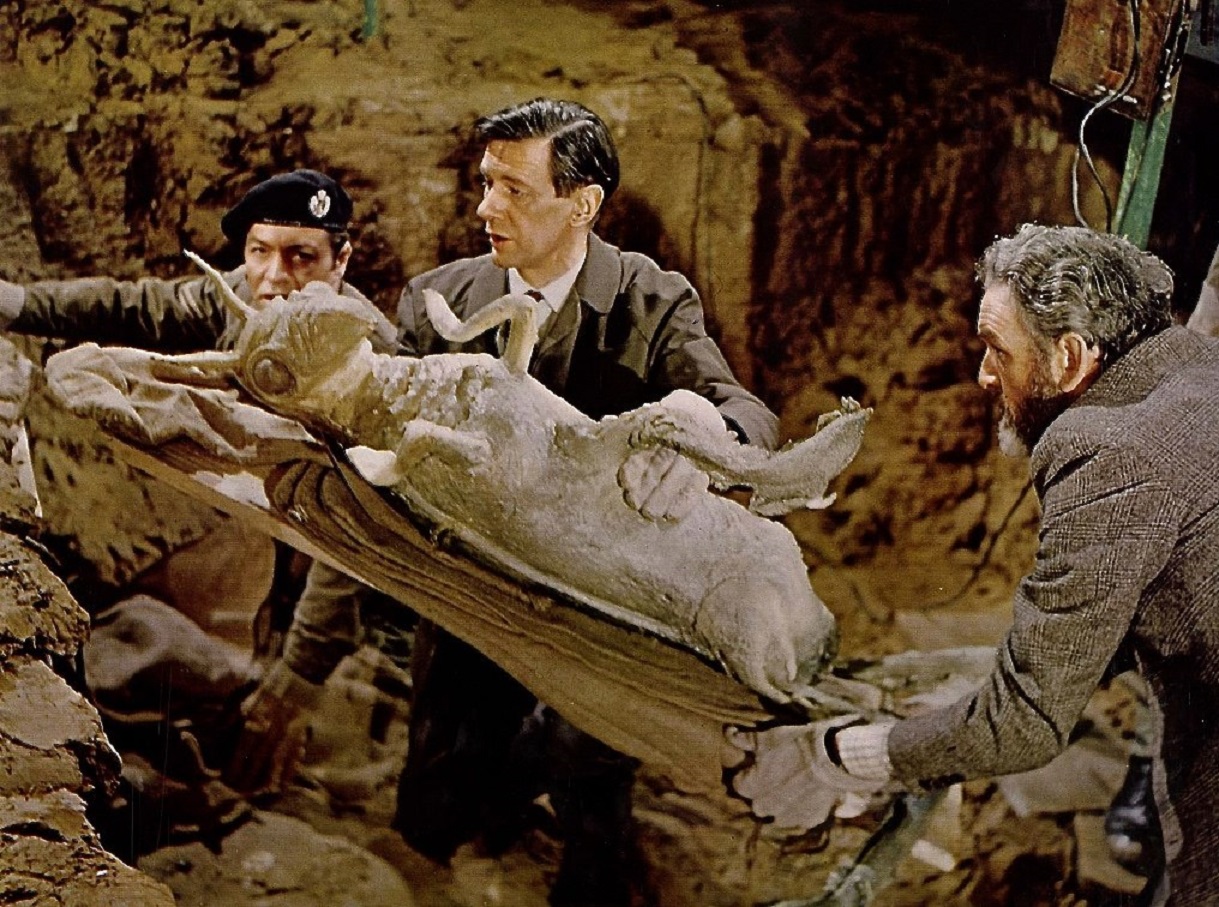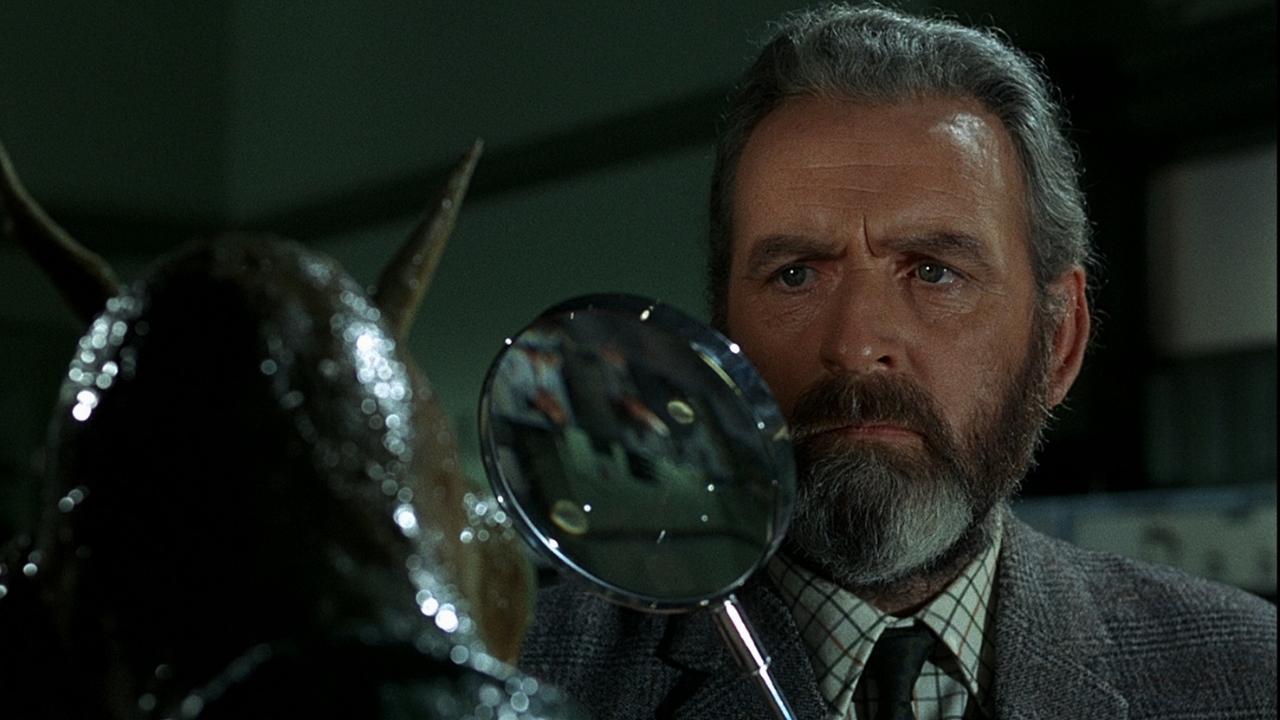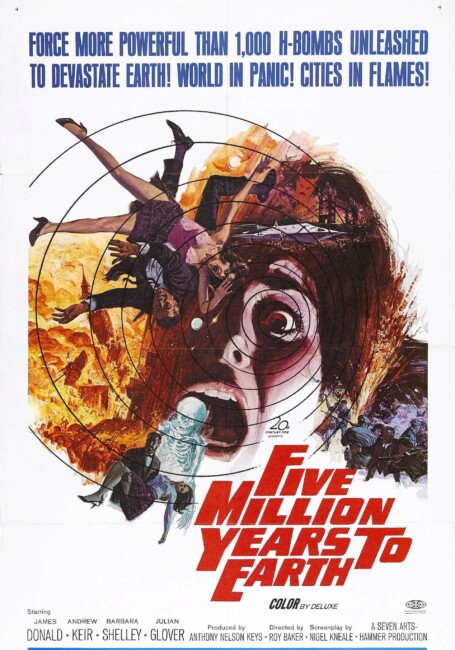aka Five Million Years to Earth
UK. 1967.
Crew
Director – Roy Ward Baker, Screenplay – Nigel Kneale, Based on his 1958-9 TV Serial Quatermass and the Pit, Producer – Anthony Nelson-Keys, Photography – Arthur Grant, Music – Tristram Cary, Special Effects – Bowie Films, Production Design – Bernard Robinson. Production Company – Hammer/Seven Arts.
Cast
Andrew Keir (Professor Bernard Quatermass), James Donald (Matthew Ronay), Barbara Shelley (Barbara Judd), Julian Glover (Colonel Breen), Duncan Lamont (Sladden)
Plot
Workmen excavating a London subway extension uncover a large metal cylinder. The Unexploded Bomb Squad are brought in, thinking it a leftover German V2 rocket but these ideas are abandoned when Professor Quatermass finds a five million-year-old human skeleton and insect creatures inside the cylinder. At the same time, there are outbreaks of psychic phenomena. Quatermass deduces that the cylinder is a rocket that came from Mars. He concludes that Martian insect creatures came to Earth five million years ago and helped humankind to gain racial consciousness. The Martian psychokinetic energy still lies dormant in mankind and the horned insect figures are dimly remembered in human racial memory as the Devil. However, with the uncovering of the spaceship, the dormant powers become active again, coalescing into a giant Devil figure of energy hovering over London.
British writer Nigel Kneale developed a cult with his trilogy of live broadcast Quatermass tv plays in the 1950s – The Quatermass Experiment (1953), Quatermass II (1955) and Quatermass and the Pit (1958-9). The rights to the plays were brought by Hammer Films, who made films out of the first two – The Quatermass Xperiment/The Creeping Unknown (1955) and Quatermass 2/The Enemy from Space (1957) – to some acclaim. Almost immediately after that, Hammer had enormous success with their The Curse of Frankenstein (1957) and Dracula/The Horror of Dracula (1958) and soon became an industry turning out horror films. Amidst this sudden explosion, Hammer’s interest in science-fiction fell by the wayside and the film rights to Quatermass and the Pit were forgotten about until nearly a decade later.
Quatermass and the Pit is often spoken of as the finest of the Quatermass films, even by people that may not rate the other three entries highly. The Quatermass Experiment was essentially a monster movie and Quatermass II a variation on the alien takeover theme, but here Nigel Kneale has expanded his ideas out with breathtaking regard. And this is what everyone loves about Quatermass and the Pit.
Throughout Nigel Kneale’s films and teleplays is a fascination with myth and fringe science having rational, real-world explanations – The Abominable Snowman (1957) reveals the Yeti as another intelligent species; The Stone Tape (1972) offers a science-fictional explanation for hauntings; and in Quatermass (1979) ancient megaliths are revealed as harvesting portals left by aliens.

Nigel Kneale is at his most ingenious in Quatermass and the Pit, which offers a dazzling array of ideas about horned Martians having seeded humanity and their insect-like form lying buried in the subconscious of racial memory, which people interpret as being The Devil. The unearthed rocket triggers off latent human psychic potential, thus offering a neat explanation for haunting and poltergeist phenomena.
Kneale has borrowed more than a few ideas from Arthur C. Clarke’s novel Childhood’s End (1953) about a race of aliens who resemble the classic image of The Devil coming to visit humanity with enigmatic purpose. Both Kneale and Clarke’s ideas were later rehashed by the Doctor Who episodes The Daemons (1972) and Image of the Fendahl (1977) and the animated Star Trek episode The Magicks of Megas-Tu (1973), while the Clarke novel was later very badly filmed as the tv mini-series Childhood’s End (2015).
As serious anthropology, this verges on the preposterous, but in terms of Nigel Kneale’s play of ideas Quatermass and the Pit is positively ingenious. It is certainly the best of the Quatermass films. Kneale tightens his original teleplay well and the suspense is eerily well built by regular Hammer director Roy Ward Baker. Particularly good is the casting of Andrew Keir as Professor Quatermass. Andrew Keir makes for a much more dignified and academic-seeming Quatermass, a welcome change from Brian Donlevy’s brutish and unlikable playing in the previous two films. (Despite such, Keir was not the first choice for the role and stats that he and Roy Ward Baker did not get on during filming).

Nigel Kneale’s other tv works are:– 1984 (1954), a live adaptation of the George Orwell novel; The Creature (1955) about the search for The Yeti; The Road (1963) about a haunting that may be an example of time travel; The Year of the Sex Olympics (1968) about a future dulled into compliance by televised sexual competitions; Wine of India (1970) about future euthanasia; The Stone Tape (1972) about a scientific investigation into a haunting; the six-episode tv anthology series Beasts (1976), which all featured unseen monsters; the seven-episode comedy series Kinvig (1981) about an SF fans who has an encounter with aliens; and the ghost story tv movie The Woman in Black (1989). Kneale’s film scripts were Quatermass 2/The Enemy from Space (1957), The Abominable Snowman (1957) adapted from The Creature, the adaptation of H.G. Wells’s The First Men in the Moon (1964), the occult film The Witches/The Devil’s Own (1966) and uncredited work on Halloween III: Season of the Witch (1982). Quatermass was later revived by the BBC in the live-broadcast tv movie The Quatermass Experiment (2005).
Roy Ward Baker became one of the prominent directors to rise in the latter decade of the Anglo-horror industry. Elsewhere, Baker made Moon Zero Two (1969), The Vampire Lovers (1970), Scars of Dracula (1971), Dr Jekyll and Sister Hyde (1971) and Legend of the 7 Golden Vampires (1974) at Hammer; Asylum (1972), … And Now the Screaming Starts! (1973) and The Vault of Horror (1973) at Amicus; and the post-Amicus The Monster Club (1980).
Trailer here

